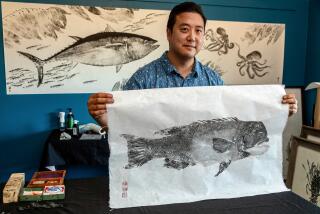Just Doodling on Stage : Sometimes Showing Lighter-Is-Better in Bass Fishing Can Bring a Backlash
- Share via
Showtime. The artist stands poised above his audience and starts his act:
“My name is Don Iovino. I’m a city boy from Burbank, California. I learned my fishing in the city . . . fishing for those freeway bass in the sewer ponds.”
His stage is the top of a mobile fish tank called the Hawg Trough, one of five that travel around the country to fishing shows so experts such as Iovino can demonstrate their skills and impart their wisdom. Iovino talks bass.
“It’s extremely important to fish light line in our waters,” Iovino tells people at the Western Fishing Tackle and Boat Show in Long Beach last week. “Most of our lakes are round, we have very little cover, we deal with a lot of suspended fish, boat traffic, water skiers, dead bodies. . . .”
The morning after, at home in Burbank, Iovino is up before dawn to catch up on his catalogue business. His garage is crammed with custom tackle that, with the help of his wife, Darlene, four grown children and a son-in-law, he distributes to the rest of the country and Japan. Most popular are the hand-poured plastic worms made by Don Cecil, “my main man,” Iovino says.
As time allows, he competes on the Western Outdoor News Bass Tour and in other events. Then it’s back to the show circuit.
“My show season starts in January,” he says. “This year has been a nightmare. I went to 14 states.”
Iovino used to commute to Huntington Park to work for Sargent Industries, a defense subcontractor. He helped develop engine control systems for the F-14, EA-6, A-10 Warthog, E2C and A-7.
But then he left the defense rat race to join a different kind of rat race. In the last few years, Don Iovino, bass fisherman, has become a corporation.
“It hasn’t been easy for me,” Iovino says. “I started at 30 years old . . . in the city. Bass fishing in the South and Midwest is a way of life. Out here trolling down Hollywood Boulevard has another meaning.”
Iovino has lived in Burbank for 50 of his 52 years, but it wasn’t until 1969 that he found his way to Lake Castaic, a short run up Interstate 5. And then he didn’t realize he was onto what was to become the hottest lake for big bass in Southern California.
“I started fishing for trout and catfish,” he says. “Bass were the farthest thing from my mind, but I used to catch them all the time . . . threw them back. Didn’t want them.
“Then one day, I saw these bass boats on the lake. One of them darn near swamped me and my son. So I went back to the launch ramp to see what they were doing, and they were weighing these little tiny bass. I’d been throwing biggies back. So I told myself, ‘I can do this.’ ”
Iovino has won several national titles and tried the “big league” Bass Anglers Sportsman Society tournament trail in the South.
“I fished five BASS tournaments,” he says, “and I was in the money in four. (But) I want to establish my priorities in developing my business. I’m a Western boy, and that’s where I’m staying. It’s a total commitment to fish BASS. You give up a lot for a pot of gold that maybe one out of 10 guys gets. I don’t want to travel all over the country chasing rainbows.”
Iovino tip: “When you don’t get any bites, keep going smaller . . . lighter line, smaller baits.”
Doodling. Someday it will be part of Iovino’s epitaph. He invented it.
“Doodling is an art form of presenting a (plastic) worm in a natural fall shake or stationary shake, in precise target areas using the proper tip rod, light line--and using your electronics to position your boat on the target area,” he explained. “We use natural colors and a quick-- bup-bup-bup-- motion. It’s a vibration shake. That’s why it’s important to have a fast-tip rod.
“Shaking worms has been around since before I was around. What I did was adapt the finesse techniques--the brass sinkers, the glass beads, the natural colored hand-poured worms, the light-wire hooks, the special doodling rod with the fast tip.”
Iovino prefers brass sinkers to lead.
“They aren’t cheap,” he says, “but they’re 10 times better because they’re four times as hard.”
He attaches the glass bead next to the sinker so, when he shakes the line, they will make a rattling noise like a crawdad--a bass’ favorite lunch.
Iovino tells the audience: “In the springtime, I like an eighth or 3/16th (inches in diameter) brass sinker. For noise I use an eight-millimeter glass bead that makes the noise and gives it reflection. I like tattle-tale worms in the spring because of the simulation of the crawdad.
“You don’t shake all the time when you’re doodling. You shake, you pull, you stop. Sometimes they’ll look at it for two or three minutes and then take it. I like to shake on the sink. I let it sit a minute and it’ll float up, and I’ll shake it some more . . . make that noise. You notice how the worm, when it fell, the tail come up? (I) shook it and (the fish) took it, didn’t he?”
Iovino took the technique south and had the nerve to tell Southerners how to fish for bass.
“For a long time,” he says, “when you said you’re from California, they didn’t want to talk to you. They didn’t want to believe in anything we did.”
He made believers of them. He told them: “Most of you old boys were born with a fishing rod in your hands. They handed me a baseball bat. For protection.”
He is probably a legend in Richmond, Va. He shows a visitor a video of his performance in January of last year, and says: “This is my first cast.”
A fish grabs the plastic worm immediately and starts munching. There’s no hook on the line, but the fish won’t let go.
“Is he eating that bait or what?” Iovino says. “I got their attention, I’ll tell you.”
The bass ignore minnows in the tank and continue to go for the worms. Iovino, who from above can only sense but can’t see what is happening, tells the audience the fish also may go for the sinker because of the noise.
“I was just telling them about it,” he says, “and the fish do it (as if) they were trained.
“Watch this now. This is really good. I’m showing them how I can get this fish to eat . . . shake, pull, stop. The tail (of the bait) comes up. Look at him grab that. That’s a bite, boy. And see the other fish take the sinker? I ‘hooked’ them both at the same time! See the people? They ain’t even talking no more.”
Iovino tip: “One of the mistakes fishermen make is not balancing the line (weight) with the rod.”
Split-shotting. Iovino credits Dick Trask with developing the technique in the West, but Iovino is a leading advocate.
“It’s a derivative of Carolina fishing,” Iovino says. “We’ve just taken a lot of old ideas and made them lighter and better . . . putting a weight 18 to 24 inches above your leader so the leader is always free-fall, instead of the Texas rig or the doodling scenario where the sinker and bait are against the worm.
“Split-shot fishing is especially effective in the shallow water in the spring and summer. It’s a deadly technique, and it’s easy to use.”
Iovino also demonstrated split-shotting at Richmond. It was a memorable experience.
“I didn’t notice that the line was getting twisted on the reel,” he says, “and when you’ve got seven (or) eight hundred people watching, it’s nerve-racking. You don’t want to embarrass yourself and have the line come off.”
But when he cast the line, it tangled in an impossible backlash. Iovino was horrified but didn’t let on. He explains: “I said, ‘Folks, what I want to show you here, I deliberately tangled this line so you can see this bait will just sit there and do its own thing and the fish will bite.’
“So, I’m talking and untangling, and the line is getting worse. All of a sudden the bass picked up the Fatzee (lure) and starts swimming with it, pulling the tangled line through the eyes of my rod. ‘That’s what I’ve been telling you, folks. You got a big old backlash and you don’t have to do nothing. These fish don’t let go of the bait.’ ”
Then he put the rod down and picked up the loose line and told the folks, “ ‘Just hand-line the fish in.’ They’re whooping and clapping and I’m thinking, ‘you’re good, Iovino.’ ”
More to Read
The biggest entertainment stories
Get our big stories about Hollywood, film, television, music, arts, culture and more right in your inbox as soon as they publish.
You may occasionally receive promotional content from the Los Angeles Times.










